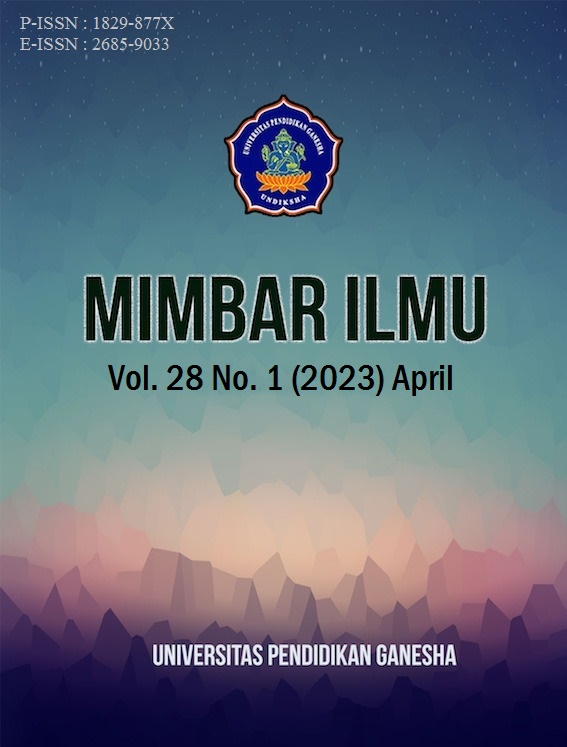Lexicostatistics of Javanese and Sasak Languages: Comparative Historical Linguistic Studies
DOI:
https://doi.org/10.23887/mi.v28i1.59797Keywords:
Lexicostatistics, Javanese, Sasak, LinguisticsAbstract
A language is related to other languages because these languages are similar to one another. The kinship between Javanese and Sasak languages can be seen in lexical and phonemic correspondences. This study aims to analyze the kinship relationship based on numerical calculations between the Javanese and Sasak languages and the lexicostatistical order of the two languages. This research uses qualitative and quantitative methods. Data were obtained using the literature study method, corresponding to Morris Swades' 200 basic vocabulary using direct note-taking techniques. Data analysis used the lexicostatistics method. The result of the research is that after lexicostatistical calculations have been carried out, the percentage of kinship between Javanese and Sasak languages is 23.8%. Based on the error analysis, it is known that Javanese and Sasak were a single language around 1553-1317 years ago. The Javanese and Sasak languages are estimated to have started to separate from Proto around 469 – 705 AD (calculated by 2022).
References
Adhiti, I. A. I. (2019). Kajian Linguistik Historis Komparatif Pada Pola Perubahan Bunyi. Kulturistik: Jurnal Bahasa Dan Budaya, 3(2), 75. https://doi.org/10.22225/kulturistik.3.2.1203. DOI: https://doi.org/10.22225/kulturistik.3.2.1203
Afria, R. A., Izar, J., Prawolo, I. S., & Arezky, B. (2020). Relasi Bahasa Melayu Riau, Bugis, Dan Banjar: Kajian Linguistik Historis Komparatif. Medan Makna: Jurnal Ilmu Kebahasaan Dan Kesastraan, 18(1), 94. https://doi.org/10.26499/mm.v18i1.2330. DOI: https://doi.org/10.26499/mm.v18i1.2330
Ahya, A. S., Subakti, H. S., & Surotin, S. (2022). Kekerabatan Bahasa Jawa Nganjuk Dengan Bahasa Jawa Jombang ( Kajian Leksikostatistik). Linguista: Jurnal Ilmiah Bahasa, Sastra, Dan Pembelajarannya, 6(1), 51. https://doi.org/10.25273/linguista.v6i1.12681. DOI: https://doi.org/10.25273/linguista.v6i1.12681
Aisyah, S., & Widayati, D. (2022). Hubungan Kekerabatan Bahasa Pesisir Pasar, Kampung, dan Sorkam (Kajian Linguistik Historis Komparatif). Aksara: Jurnal Ilmu Pendidikan Nonformal, 8(3), 2367. https://doi.org/10.37905/aksara.8.3.2367-2376.2022. DOI: https://doi.org/10.37905/aksara.8.3.2367-2376.2022
Erni, N., Taha, M., Febriningsih, F., Wijaya, D., & Garing, J. (2022). Bahasa Lorang, Bahasa Barakai, Dan Bahasa Dobel Di Kepulauan Aru Dalam Kajian Leksikostatistik (Lorang Languages, Barakai Languages, and Dobel Languages in Aru Islands in Lexicostatistic Study). Kandai, 18(1), 61. https://doi.org/10.26499/jk.v18i1.3197. DOI: https://doi.org/10.26499/jk.v18i1.3197
Erniati, E. (2021). Klasifikasi Leksikostatistik Bahasa Banggoi Dan Bahasa Hoti Di Kabupaten Seram Bagian Timur [Lexicostatistic Classification Of Banggai And Hoti Language In East Seram District]. Totobuang, 9(2), 239–255. https://doi.org/10.26499/ttbng.v9i2.333. DOI: https://doi.org/10.26499/ttbng.v9i2.333
Gani, S., & Arsyad, B. (2019). KAJIAN TEORITIS STRUKTUR INTERNAL BAHASA (Fonologi, Morfologi, Sintaksis, dan Semantik). Jurnal Bahasa Dan Sastra Arab, 7(1), 1. https://doi.org/10.31314/ajamiy.7.1.1-20.2018. DOI: https://doi.org/10.31314/ajamiy.7.1.1-20.2018
Hadi, N. R. P., & Kusumaningrum, S. (2020). Korespondensi Fonemis Bahasa Ogan Dan Bahasa Bangka. Jurnal Culture (Culture, Language, and Literature Review), 7(2), 191–203. https://doi.org/10.53873/culture.v7i2.222. DOI: https://doi.org/10.53873/culture.v7i2.222
Hafizah, H. (2018). Leksikostatistik Bahasa Indonesia dengan Bahasa Minang Dialek Bukittinggi (Kajian Linguistik Historis Komparatif). Deiksis, 10(03), 247. https://doi.org/10.30998/deiksis.v10i03.2757. DOI: https://doi.org/10.30998/deiksis.v10i03.2757
Hakim, L. (2020). Sapaan Kekerabatan Bahasa Sasak Di Desa Beraim, Kecamatan Praya Tengah, Lombok Tengah. Mabasan, 14(2), 329–340. https://doi.org/10.26499/mab.v14i2.426. DOI: https://doi.org/10.26499/mab.v14i2.426
Hilmi, M. (2017). Leksikostatistik Bahasa (Sasambo) Bahasa Sasak, Bahasa Sumbawa/Samawa, dan Bahasa Bima/Mbojo : Kajian Linguistik Historis Komparatif. Fondatia, 1(1), 165–176. https://doi.org/10.36088/fondatia.v1i1.94. DOI: https://doi.org/10.36088/fondatia.v1i1.94
Iqbal, M., Nasution, J., & Dardanila, D. (2022). Kekerbatan Bahasa Angkola Dan Bahasa Aceh: Kajian Linguistik Historis Komparatif. Jurnal Dedikasi Pendidikan, 6(2), 395–402. https://doi.org/10.30601/dedikasi.v6i2.2934. DOI: https://doi.org/10.30601/dedikasi.v6i2.2934
Jamzaroh, S. (2020). Hubungan Kekerabatan Bahasa Barangas dan Bahasa Bakumpai di Kalimantan Selatan. Mabasan, 14(1), 1–16. https://doi.org/10.26499/mab.v14i1.281. DOI: https://doi.org/10.26499/mab.v14i1.281
Kumala, S. A., & Lauder, M. R. (2021). Makna Toponim di Tangerang sebagai Representasi Keberadaan Etnis Cina Benteng: Sebuah Kajian Linguistik Historis Komparatif. Ranah: Jurnal Kajian Bahasa, 10(2), 304. https://doi.org/10.26499/rnh.v10i2.4048. DOI: https://doi.org/10.26499/rnh.v10i2.4048
Lailiyah, N., & Wijayanti, F. I. (2022). Kekerabatan Bahasa Jawa, Bali Dan Bima: Perspektif Linguistik Historis Komparatif. Linguistik Indonesia, 40(2), 327–345. https://doi.org/10.26499/li.v40i2.308. DOI: https://doi.org/10.26499/li.v40i2.308
Mailani, O., Nuraeni, I., Syakila, S. A., & Lazuardi, J. (2022). Bahasa Sebagai Alat Komunikasi Dalam Kehidupan Manusia. Kampret Journal, 1(1), 1–10. https://doi.org/10.35335/kampret.v1i1.8. DOI: https://doi.org/10.35335/kampret.v1i1.8
Mayangsari, D. (2020). Leksikostatistik Bahasa Bugis dan Bahasa Toraja (Lexicostatistic of Bugis Language and Toraja Language). Jalabahasa, 16(1), 83–96. https://doi.org/10.36567/jalabahasa.v16i1.471. DOI: https://doi.org/10.36567/jalabahasa.v16i1.471
Muhammad, S. R., & Hendrokumoro, H. (2022). Hubungan Kekerabatan Bahasa Aceh Dan Bahasa Gayo: Kajian Linguistik Historis Komparatif. Metahumaniora, 12(2), 171. https://doi.org/10.24198/metahumaniora.v12i2.40891. DOI: https://doi.org/10.24198/metahumaniora.v12i2.40891
Napitupulu, L. H., & Silaban, Y. N. (2020). Kajian Leksikostatistik Pada Bahasa Batak Toba Dan Batak Angkola Mandailing. Jurnal Bahasa Indonesia Prima (BIP), 2(2), 82–90. https://doi.org/10.34012/bip.v2i2.1336. DOI: https://doi.org/10.34012/bip.v2i2.1336
Nugraha, D. D., & Prasetiyo, A. B. (2022). Penggunaan Bahasa Jawa Di Lingkungan Pesantren Wilayah Banyuwangi Selatan. Sintesis, 16(1), 41–49. https://doi.org/10.24071/sin.v16i1.4204. DOI: https://doi.org/10.24071/sin.v16i1.4204
Rizqi, F. A., & Widayati, D. (2021). Perubahan Bunyi Bahasa Proto Austronesia Ke Dalam Bahasa Jawa Dialek Sumatera (Kajian Linguistik Historis Komparatif). Kulturistik: Jurnal Bahasa Dan Budaya, 5(2), 29–35. https://doi.org/10.22225/kulturistik.5.2.3380. DOI: https://doi.org/10.22225/kulturistik.5.2.3380
Setiawan, L. G. I. P. S. (2020). Hubungan Kekerabatan Bahasa Bali Dan Sasak Dalam Ekoleksikon Kenyiuran: Analisis Linguistik Historis Komparatif. Jurnal Inovasi Penelitian, 1(1), 27–30. https://doi.org/10.47492/jip.v1i1.44. DOI: https://doi.org/10.47492/jip.v1i1.44
Sholeha, M., & Hendrokumoro, H. (2022). Kekerabatan Bahasa Kerinci, Melayu Jambi, dan Minangkabau. Diglosia: Jurnal Kajian Bahasa, Sastra, Dan Pengajarannya, 5(2), 399–420. https://doi.org/10.30872/diglosia.v5i2.404. DOI: https://doi.org/10.30872/diglosia.v5i2.404
Soniatin, Y., & Widyaningsih, A. (2022). Hubungan Kekerabatan Bahasa Jawa (Karanggeneng) Dan Bahasa Madura (Pamekasan). Pentas : Jurnal Ilmiah Pendidikan Bahasa Dan Sastra Indonesia, 8(1), 1–8. https://doi.org/10.52166/pentas.v8i1.3283. DOI: https://doi.org/10.52166/pentas.v8i1.3283
Surip, M., & Widayati, D. (2019). Kekerabatan Bahasa Jawa Dan Bahasa Gayo: Kajian Linguistik Historis Komparatif. Jurnal Bahasa Lingua Scientia, 11(1). https://doi.org/10.21274/ls.2019.11.1.1-26. DOI: https://doi.org/10.21274/ls.2019.11.1.1-26
Syafi’i, I. (2019). Leksikostatistik Lima Bahasa Nusantara: Bahasa Jawa, Bahasa Madura, Bahasa Sunda, Bahasa Bali, dan Bahasa Indonesia. Basindo : Jurnal Kajian Bahasa, Sastra Indonesia, Dan Pembelajarannya, 3(1), 85–93. https://doi.org/10.17977/um007v3i12019p085. DOI: https://doi.org/10.17977/um007v3i12019p085
Downloads
Published
How to Cite
Issue
Section
License
Copyright (c) 2023 Mahriyuni, Isda Pramuniati, Rizky Ainun Maftuhah

This work is licensed under a Creative Commons Attribution-ShareAlike 4.0 International License.
This work is licensed under a Creative Commons Attribution-ShareAlike 4.0 International License.
Authors who publish with this journal agree to the following terms:
- Authors retain copyright and grant the journal right of first publication with the work simultaneously licensed under a Creative Commons Attribution-ShareAlike 4.0 International License that allows others to share the work with an acknowledgment of the work's authorship and initial publication in this journal.
- Authors are able to enter into separate, additional contractual arrangements for the non-exclusive distribution of the journal's published version of the work (e.g., post it to an institutional repository or publish it in a book), with an acknowledgment of its initial publication in this journal.
- Authors are permitted and encouraged to post their work online (e.g., in institutional repositories or on their website) prior to and during the submission process, as it can lead to productive exchanges, as well as earlier and greater citation of published work.






